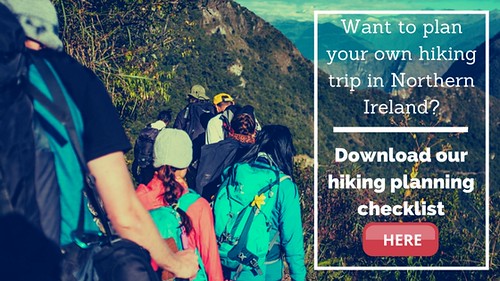Hiking is a popular pastime in Ireland for both serious hillwalkers and newbies looking to jumpstart a healthier lifestyle. For travelers, it can also be a wonderful way to see a beautiful country, to meet new people, and to learn about the history, culture, flora, and fauna of the Emerald Isle.
A quick google search will yield an overwhelmingly long list of hiking-focused tours, guides, festivals, and other resources. In Ireland’s more remote and wild north – County Donegal in the Republic and Antrim and the Causeway Coast in Northern Ireland – the list is somewhat shorter, but there is still a lot of information to bushwhack your way through.
Time Travel Adventures has just finished putting together Irish Tales & Trails: Hiking & History in Northern Ireland & Donegal, an 11-night small-group tour taking off in Summer 2018. We want to share with you some tips to help navigate through the information and to plan your own hiking adventure, whether that is solo, with a friend (or a few), or joining a group.
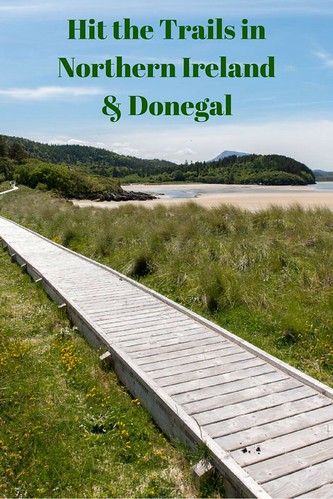
Tip #1: Who is traveling and what are you looking for?
Are you planning for a solo vacation? A couples’ romantic getaway? An adventure for a few friends? A larger tour group of students or adults? The answer will minimize your time spent on research by defining what you are looking for:
• A group you can join for a day, a weekend, or a week.
• A self-guided itinerary, which can mean more than just a map. Many outfits will reserve lodging and restaurants. Some are ready to offer support along the way, including assistance by phone and transportation if needed.
• An independent guide who can lead a group you are bringing to Ireland.
Tip #2: What level of walking are you up for?
Every company, guide and itinerary is different and it is easy to misinterpret a website description or brochure. One person’s “moderate difficulty” can feel like mountaineering to me! Be sure to ask questions and know what you are getting into:
• What distance is covered over how many hours?
The average adult walks 3 miles per hour on flat, paved ground. Unless you are an athlete looking for a workout, you will want a slower pace due to uneven terrain and stops for banana breaks, lunch and photos. Remember, 1 mile = 1.609 kilometers. To convert distance from kilometers to miles multiply by .62.
• What kind of terrain will you encounter?
Most often this will be a mix of grass, stone steps, and dirt or gravel paths. There may also be stiles and kissing gates – steps and gates that allow people but not animals to pass. More challenging walks may involve scrambling up rocks or crossing wet bog.
• How much elevation gain should you expect? Will there be undulating hills?
Keep in mind that 1 meter = 3.3 feet and a typical flight of stairs is vertically 10 to 12 feet.
• How does the guide deal with different capabilities in a group?
Larger outfits can sometimes divide hikers into two cohorts so that folks looking for a greater challenge take a different trail from those wanting something less strenuous. But in smaller groups, your guide may have to choose a happy medium to appeal to different tastes. This could mean you find the walks a bit easy or rather challenging.
• What happens if the weather is terrible?
I’m not talking about everyday rain or wind. Ireland is a wee bit wet, and you will want to be ready to hike in those conditions. I’m talking about absolute, nonstop downpours and gale force winds. Professional guides know how to judge the weather, decide which trails are best for different conditions, and gauge the endurance of the group. Is there a plan for a rain-day? This could include sightseeing in a nearby town, a visit to a local recreation center with a hot tub, shopping at local art studios…
Tip #3: What kind of lodging and meals do you want?
Lodging can vary from rustic hostels to luxury inns and everything in between. Some tours will include most or all meals – which means a lot of together time with the group – and others will leave dinners up to you. The price of your hiking holiday will reflect these variances. If you are not sure from the website and brochure the exact accommodations or where meals are taken, be sure to ask and then look them up on a good travel website like TripAdvisor. Just about any dietary restrictions can be tailored to these days, but be sure to ask in advance, if this applies to you.
If you are planning the logistics for you own hiking itinerary, don’t forget to ask your hotel or bed and breakfast if they will prepare a pack lunch for you. This is routinely available for approximately €8 and will save you precious time on your vacation.
Some hiking itineraries entail changing accommodations every one or two nights with your luggage transported for you. Other tours are based around one location, with drivers dropping you off and picking you up at trail heads. While the former allows you to cover more territory, the latter gives you a chance to unpack and relax a bit. It is worth asking how long the drive will take to and from the trails each day. Donegal is particularly remote and may require 45 minutes or more driving each way to reach the spectacular hiking ahead of you. The drive is usually scenic, but it can make for a long day.
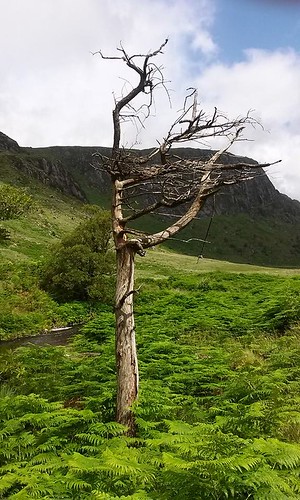
Glenveagh National Park
Tip #4. What should you pack?
Your guide or tour company will tell you what essentials to bring, but here are our suggestions:
• Hiking boots with good ankle support are important. These should be broken in. Don’t attempt to hike in new boots; you will be miserable. If you are doing just a day hike, you can probably get away with hiking shoes -- that is, a good tread but no ankle support. Sneakers are not a good idea due to slippery wet trails or loose gravel.
• Adhesive bandages and moleskin are good to have on hand, just in case. But, with proper boots and socks, you won’t need them.
• Rain pants, a water proof or repellent jacket, and a water proof cover for your backpack will come in handy in Ireland. It’s amazing how pleasant walking in the rain can be when you have gear that keeps you dry.
• Breathable hiking pants and shirts, plus a warm fleece hoodie to layer on and off will help keep you comfortable. If you are hiking in winter, warmer clothes will be needed.
• Because it doesn’t always rain in Ireland, be sure to pack a sunhat, sunglasses, and sunblock. Maybe even hiking shorts!
• A bottle for water or a thermos for hot tea or coffee is another must-have. Your hotel or bed and breakfast will usually fill these for you before you head out.
• A sit-pad to use on your pack lunch break on the trail is also a good idea. You can buy these in sporting goods stores like REI, although I prefer to improvise with plastic bags, or a cut-up tarp or yoga mat.
• Don’t forget to carry a bit of cash for the unexpected pub or café stop, plus toilet paper (in a plastic baggie) in case you need a nature break in, well… in nature.
• Whether you want gaiters (covers that go over your hiking boots and lower legs of pants to protect you from wet conditions) and walking poles (for stability) is up to you and the kind of trails you expect. A novice on fairly easy trails won’t need them.

Tip #5: Partners we love in Donegal and Northern Ireland
Away a Wee Walk: Eimear Flanagan and her team are based in Belfast and offer a number of half and full-day guided walks along the Giant’s Causeway Cliff Path. More independent travelers may like their three, four, and five-night self-guided walking holidays along the Causeway Coast and the Glens of Antrim, with lodging included.
Dalriada Kingdom Tours: Through this family-run business, Mark and Rosemary Rodgers are proud to offer guided tours of the Causeway Coast, Rathlin Island, and Dunluce Castle. With family roots on the Causeway dating back hundreds of years, Dalriada Kingdom emphasizes the history of their homeland and the stories of its people. They are also available to create a bespoke travel experience just for your group.
Walking Donegal: A native of Donegal, Seamus Doohan is an experienced guide available for daily hire. He offers a wide list of trails to suit every level and brings a rich knowledge of the history, flora and fauna of his home. He can also help with lodging and transportation arrangements, if desired. A former member of the Irish Defense Forces, Seamus is an active member of the North West Mountaineering Club.
Walking & Talking in Donegal and Walking & Talking in Ireland: Sean Mullan, a native from Derry now based on the Fanad Peninsula, is an experienced hiking guide (and former teacher) offering spectacular walks in Donegal and Antrim, including Rathlin Island. His calendar includes weekends and full week itineraries with lodging and meals included. Sean’s regular groups are small and attract interesting people from around the world, making it a great option for solo travelers, couples and friends looking for good company. He can also arrange an all-inclusive hiking vacation for groups.
Time Travel Adventures: Of course, you can also join Irish Tales & Trails, an 11-day small-group experience coming up in Summer 2018. Combining history-focused activities in Belfast and Derry with four days of hiking on the Causeway Coast and in Donegal, Irish Tales & Trails is the perfect blend of urban and outdoor fun. Time Travel Adventures can also create custom tours for groups of students or adults.

Tip #6: A word about walking festivals & rambling clubs
There are walking festivals and rambling clubs in almost every corner of Ireland – a testimony to the popularity of trekking for people of all ages. Many arrange hikes for newbies as well as serious hillwalkers, and they are a great way to meet local people on your vacation. Even if you are staying in a town or city, like Belfast, Derry, Ardara, or Letterkenny, you can often find walking groups – via google or Meetup.com – with carpools or public transit directions taking you to some beautiful countryside.
If you choose to go this route, please remember that you are a guest on walks that are often organized by volunteers for recreational purposes.
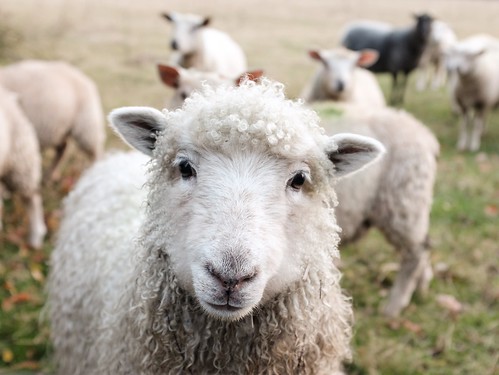
Wherever you choose to go, and however you get there, remember these wise words from the conservationist, John Muir: “In every walk with nature, one receives far more than he seeks.”
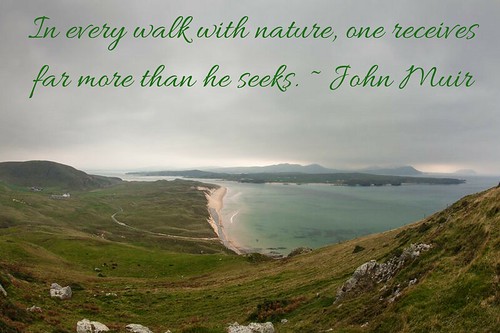
Happy trails!
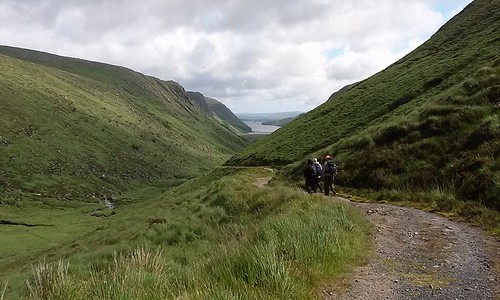
Glenveagh National Park
Shella Brenner is an experience designer and tour manager for Time Travel Adventures, an emerging, boutique travel company owned by a woman of color and run by women who are passionate about experiential and educational travel. They specialize in custom itineraries and small group tours based on affinity concepts. Their Summer 2018 calendar kicks-off with Irish Tales & Trails: Hiking & History in Northern Ireland & Donegal – suitable for casual walkers with reasonable fitness – followed by Dublin City / Dublin Writers.
Photo credit, in order of appearance:
Ards Forest Park, Sheephaven Bay. Photo courtesy and copyright Martin Fleming, used with permission from Fáilte Ireland, Tourism Ireland, adapted by Wandering Educators
Glenveagh National Park. Photo courtesy and copyright Shella Brenner
Hiking the Sliabh Liag Path. Photo courtesy and copyright Martin Fleming, used with permission from Fáilte Ireland, adapted by Wandering Educators
Creative Commons photo by Adam Markon via Unsplash
Creative Commons photo by Sam Carter via Unsplash
Coastal and Landscape View of the Seven Finger Strand Donegal. Photo courtesy and copyright Sinead McCarthy, used with permission from Fáilte Ireland, adapted by Wandering Educators
Glenveagh National Park. Photo courtesy and copyright Shella Brenner

